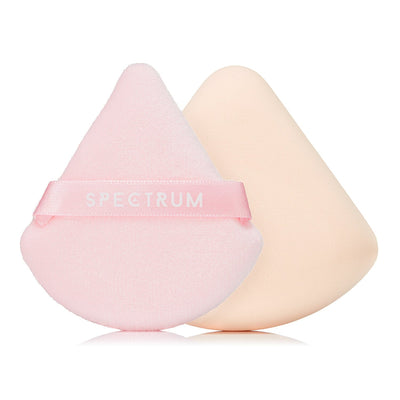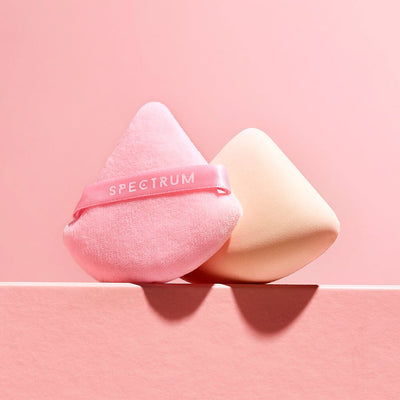Why Does My Makeup Look Cakey?

Makeup Looking Cakey, Patchy, Dry or Oily? Here’s How To Fix It
You do a full face of makeup, only to notice it looks cakey, patchy, dry, or even oily halfway through the day. Sound familiar? We thought so. (Don’t worry it happens to the best of us!) What if we told you it’s not always your makeup’s fault? From using the wrong skincare products to not cleaning your brushes, we take a look at why your makeup isn’t applying how you want—and what you can do to fix it.
Q: Why does my makeup look cakey?
A: Your makeup might look cakey (i.e. thick, heavy and really noticeable on your skin) for many reasons. Some of the main culprits are that you’re not prepping your skin correctly, meaning your complexion products don’t sit on your skin properly. You’ll also probably notice your foundation or concealer sliding around on your face during the day too.
Or it could be that you’re using too much product (not to be confused with too many products). Applying layers upon layers of makeup will cause your base products not to blend properly, leading to creasing under your eyes and caking on your cheeks.
Don’t panic, because there are a few quick fixes to cakey-looking makeup.
Our makeup artist Hannah gives her expert advice:
“Applying too much foundation at once, can cause makeup to crack or sit heavy! Start off with a super light veil of foundation, then build up in specific areas wherever you feel like you need more coverage. OR spot conceal with a small brush on any blemishes.”
“Avoid applying too much foundation on areas like your smile lines or under eyes. These areas are prone to creasing. So too much foundation or concealer can cause the product to settle into the lines and enhance them.”
“A technique that is trending at the moment, is under-painting. Where you apply your cream bronzer and concealer first, before foundation. Then buff a light layer of foundation over the areas free of product. The result is super seamless and basically means you've only applied one lighter layer of product.”
Bonus Tip: Applying a primer to your skin will help to create a smooth base for makeup application. A setting spray will help to lift away any cakey powdery residue, as well as keep your look in place all day. Sounds like a win-win!
Q: Why does my makeup look dry?
A: The most likely reason your makeup looks dry is that your skin is dry. If you’re skipping the exfoliating or moisturizing step in your skincare routine, your skin could be drying out. Makeup will cling to dry, flaky patches – especially if you’re using drying formulas like matte liquids and powders too.
Our advice: Make sure you’re exfoliating your skin 2–3 times a week (either with a physical or chemical exfoliator). Aswell, always apply a moisturizer that’s recommended for your skin type—after cleansing, but before applying makeup.
Take a look at the cosmetics you’re using too. If your skin is prone to dryness try to avoid mattifying formulas and powders, and instead, opt for liquid formulas that hydrate and nourish your skin.
Q: Why does my makeup look patchy
A: It’s frustrating when you think you’ve finally found your hero formulas, only to notice they’re still looking patchy on your skin. There’s a simple reason why this could be happening (once you know it!). Makeup is either silicone-based or water-based, and if you mix the two, it’s the recipe for a patchy mess.
On top of this, if you haven’t given your brushes a good clean in a few weeks (we’re not judging, we’ve all been there!), this could be the culprit too. Product build-up on the bristles won’t do you any favors when it comes to blending your cosmetics.
Our advice: First, you must ensure you’re using either all silicone - or water-based products. Use silicone-based if you have oily skin, and water-based if you have dry skin. You can easily identify silicone-based products as the first few ingredients will end in -cone/-methicone/-siloxane. And if it’s not silicone, it will be water-based.
Second, you’ll want to pick up a brush cleaner to remove any product and bacteria build-up from your brushes. This will ensure an even and non-patchy makeup application.
Above image: Spectrum MUA, Hannah
Q: Why does my makeup look oily after a few hours?
A: Having a skincare routine that works for your skin type, and choosing the right cosmetics, play a big part in keeping your skin oil-free throughout the day. If you have oily skin and you’re using foundations, concealers, BB creams or other liquid formulas with a dewy or satin finish, you’ll probably find that these are too hydrating.
Also, using expired makeup products can irritate your skin, causing oiliness and pore-clogging too. Check the date on your cosmetics and replace any that have expired.
Our advice: Don’t skip your moisturizer! It’s a common myth that oily skin types don’t need to moisturize, but your skin can actually end up producing even more oils to stay hydrated. Pick up an oil-free moisturizer and apply it each day after cleansing.
Follow with a mattifying primer to help blur imperfections, smooth enlarged pores and absorb oils. Choose matte formulas and powders that won’t add extra shine to your skin. If you still find your skin is oily throughout the day, use blotting papers to absorb any excess oils.
Hannah’s tip:
“Use oil blotting sheets throughout the day if you get oily, to blot away any shine and re-apply powder. Applying powder onto the oil can cause the foundation to look cakey.”
“Apply a hydrating setting spray in between steps. So once after foundation, and again after your powders. Finish with a fixing spray that is designed for longevity to ensure your makeup doesn't separate. You can also refresh your makeup throughout the day with a spritz of the hydrating spray.”
Q: Why does my makeup look flakey?
A: There are a few culprits for flakey-looking makeup. One is that you could be exfoliating too much, contributing to dry skin and flakey patches. While we’re on the subject of dry skin, you need to make sure you’re cleansing and moisturizing too. This ensures you’re removing all of your makeup – and the day’s oil and debris build-up – and your moisturizer can sink into your skin to restore hydration.
Our advice: Put down the powder formulas. These tend to cling to dry patches (and further dry out already dry skin!). Switch to hydrating liquid formulas that have a dewy or satin finish. They’ll nourish your skin and give you an enviable glow.
The Takeaway
While there are a few reasons why your makeup could be looking dry, flakey, oily, or patchy, try to make one adjustment to your skincare and/or makeup routine at a time. That way you can easily identify the main culprit and find a beauty routine that works for your skin type. As everyone’s skin is unique, it might take a little bit of trial and error, but keep at it and you’ll be on your way to creating MUA-worthy looks in no time.






